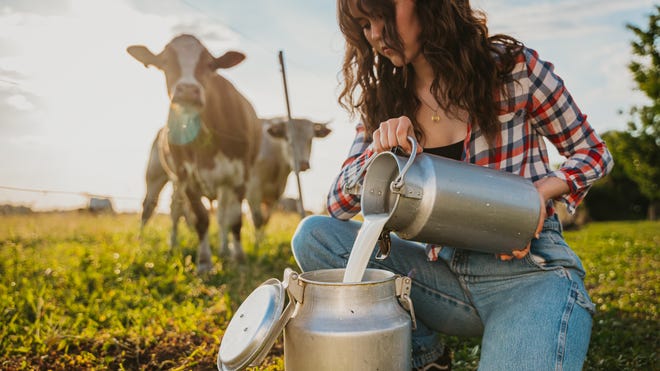There’s a growing movement in the health and wellness community to move away from highly-processed foods.
Cow’s milk has become wrapped up in that movement. Wellness influencers online claim that raw milk is healthier and safer than the usual pasteurized kind you buy in a grocery store. But health experts beg to differ.
“It’s shared by pro-raw milk drinkers that pasteurization makes cow’s milk less nutritious, but that isn’t true at all,” registered dietitian Jamie Nadeau tells USA TODAY. “When you’re weighing the pros and cons, it just doesn’t make sense to choose raw milk.”
Here’s what diet and food safety experts want you to know about the safety issues that arise with raw milk.
What is raw milk?
Raw milk is milk that has not gone through the pasteurization process, which is a key food safety step that applies heat in order to kill microorganisms that can cause disease, says Meghan Davis, DVM, MPH, PhD, an associate professor at the Johns Hopkins Bloomberg School of Public Health.
“The risk is present with some foods like fresh produce, which is why we recommend thorough washing steps for fresh fruits and vegetables, and is magnified with food animal products (such as) meat and milk, especially those where the meat you eat or the milk you drink has been processed with thousands of others,” Davis says. “It’s not the risk from one animal, it’s the risk that any one of the thousand or more animals might be shedding or contaminated with any given pathogen.”
Some people believe that raw milk is healthier than pasteurized milk because it’s “less processed.” That’s just not true, Nadeau says.
More:More than 100 people sickened by salmonella linked to raw milk from Fresno farm
“The nutrition changes that happen after pasteurization is extremely minimal,” she says. “Pasteurized milk is just as nutritious as raw milk, and it’s much safer.”
If it’s a less-processed milk that you’re after, Davis recommends buying commercially pasteurized but non-homogenized milk, which is also known as cream top. “This has undergone the food safety step: temperature and pressure, but not the additional processing steps,” she says.
There are also misconceptions that the bacteria content in raw milk is good for your gut, but those ideas are “far-fetched,” Nadeau adds. She recommends foods like yogurt, kefir, kombucha or a probiotic supplement if you’re trying to incorporate more gut-heathy items to your diet.
Is it safe to drink raw milk?
Several leading health organizations — including the U.S. Food and Drug Administration (FDA), Centers for Disease Control and Prevention (CDC) and the American Academy of Pediatricians — all warn against the consumption of raw milk, citing serious health issues that can put both the person consuming it as well as people around them at risk.
That’s right — by consuming raw milk, you can actually threaten the health and safety of those around you, even if they didn’t consume the milk, Davis notes. And those with compromised immune systems, including “toddlers, children, pregnant women or the elderly” are especially susceptible to getting sick.
Seriously, don’t drink the raw milk:Social media doubles down despite bird flu outbreak
“Raw cow’s milk is unsafe to drink because it can contain harmful pathogens,” Nadeau says. “Some of the pathogens found in raw milk can cause serious life-threatening disease like Guillain-Barré syndrome and hemolytic uremic syndrome.”
Bacterial contamination isn’t the only risk, either. The U.S. Department of Agriculture recently announced that it would begin bulk testing batches of raw milk across the country for the avian flu, which began rapidly spreading across cattle in California earlier this year.
The good news: pasteurization is designed to kill all of those harmful bacteria and viruses, Davis says. Experts say the potential risks and equal nutritional values make choosing pasteurization a no-brainer.
“Unfortunately there’s no way to guarantee raw milk is safe, even if you get it from a farm that you trust,” Nadeau says. “You can get sick from raw milk that’s from the same brand and same source that you’ve previously drank from. Regardless of how healthy the animals are or how well-maintained the farm is, you can still get sick.”
